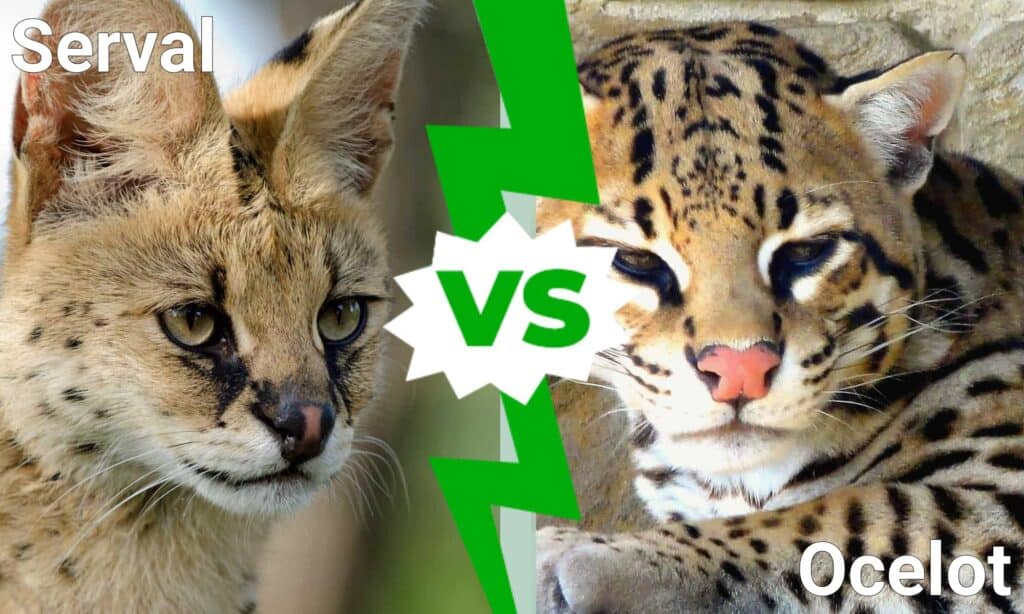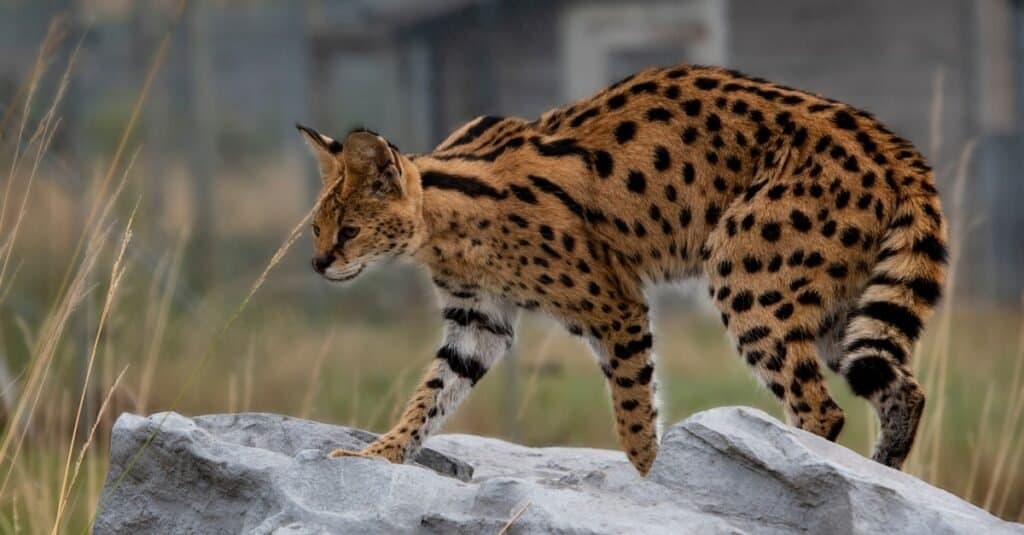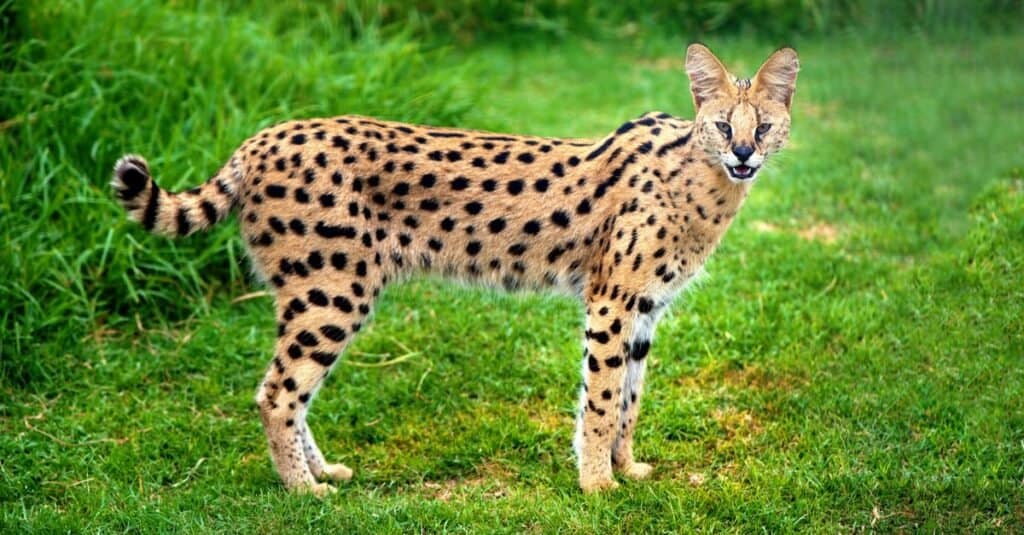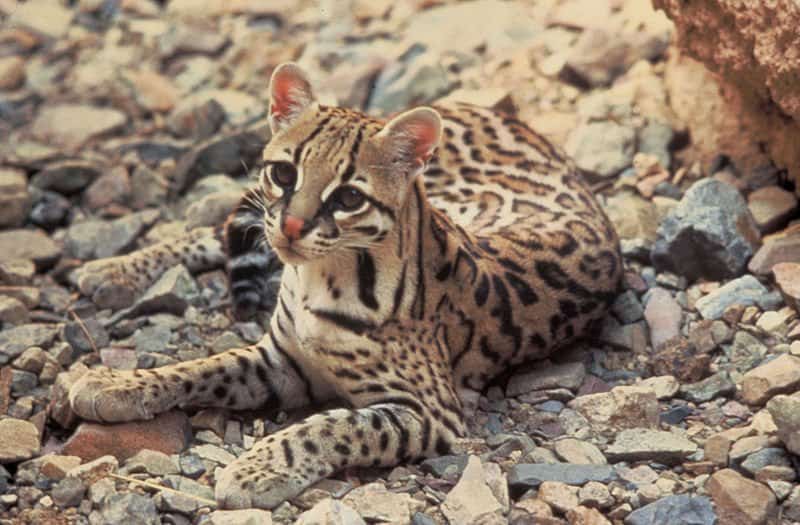What do you know about serval vs. ocelot? Can you tell the difference between these two creatures? The serval and ocelot are both wild cats, but their relationship ends there. These two cats aren’t even on the same continent! Although they may look alike at first glance, they are wildly different in many ways. In this article, we discuss eight key differences between these amazing cats.
Serval vs. Ocelot: A Comparison

| Serval | Ocelot | |
|---|---|---|
| Size | Up to 39 in tall; 7 to 42 lbs. | 22 to 40 inches tall, 25 to 35 lbs. |
| Colors | Varied Shades of Gold with Black Spots | Two Cheek Stripes, White Around Eyes, Golden Coat, “Bengal” Spotting |
| Physical Features | Long Legs, Small Head, Short Tail | Long Tail, Slim Body, Rounded Ears |
| Danger | Rarely Hostile Towards People | Prone to Biting |
| Diet | Rodents, Birds, Reptiles, Insects | Rabbits, Rats, Fish, Frogs |
| Lifespan | 10 to 20 Years | 8 to 12 Years |
| Habitats | Africa | All Over Western Hemisphere |
| Habits | Nocturnal, Solitary Cat | Shy, More Active at Night |
Serval vs. Ocelot: Key Differences
The key differences between the ocelot and the serval are their size, appearance, lifespan, habitat, diet, and habits.
At first glance, the ocelot and the serval are both medium-sized wild cats that look the same. You can even mistake them for stray house cats if you see them from afar. However, these two are significantly different from one another. For example, the ocelot is a nocturnal wildcat of Central America and South America, whereas the serval is a slenderer wildcat that lives in Africa. Let’s explore their differences even more!
Size

Servals weigh more than ocelots.
©Joanne_Charnwood/Shutterstock.com
Servals are usually seven to 42 pounds and 39 inches tall or smaller in size. Future generations are more likely to reach the size of a large domestic house cat.
Ocelots are larger than housecats but barely reach the knees of an adult male human. Female ocelots are slightly smaller than males. Ocelots grow to be roughly 22 to 40 inches tall. Females weigh 14.5 to 25 pounds, while males weigh 15 to 34 pounds.
Colors
Ocelots have two cheek stripes, white fur around the eyes, and stripes running atop the head from each eye. They are highly well disguised, with a golden coat in woodland habitat and a greyish tinge to their fur in scrubland. They have Bengal-like spots and black stripes around the tail.
Servals come in four assorted colors, the most frequent of which are varied shades of gold with black spots. Solid black, white, and patterns of little freckling from head to toe are also possible, but they’re uncommon.
Physical Features
The ocelot has a long tail and a slim body with rounded ears. Serval is a slim wildcat as well. In the cat family, it has the longest legs in proportion to its body size. Servals are easily identified by their small head, huge, oval, tightly spaced ears, and short tails.
Danger

The serval cat has a bite much stronger than the average domestic cat.
©Howard Klaaste/Shutterstock.com
A serval cat can bond with people if domesticated, as they are usually solitary animals. Although they are rarely hostile toward humans, keeping one as a pet is dangerous, and approaching them in the wild is never recommended. Servals can hiss, scratch, and bite if they feel threatened or even when they are playing.
Ocelots are prone to biting; therefore, you should keep away from them. When attacking, they will frequently target specific regions of the body, such as the groin, elbow, armpit, or neck. Be aware that they are also highly swift and agile.
Diet
Ocelots are nocturnal cats that hunt rabbits, rats, iguanas, fish, and frogs with exceptional vision and hearing. They also climb trees in search of monkeys or birds. They do not avoid water and can swim well, unlike many cats. Ocelots, like other cats, have evolved to eat meat.
Rodents, birds, reptiles, frogs, and insects are among the prey that servals consume. Many of their prey is caught by leaping high into the air and pouncing. They’ve also been seen reaching into burrows or catching fish out of the water with their lengthy forelimbs.
Lifespan
Servals live for about 10 years in the wild and up to 20 years in captivity. Ocelots have an average lifespan of eight to 12 years.
Habitat
The ocelot can be found all over the Western Hemisphere, from Southern Texas to Northern Argentina. Tropical and subtropical rainforests in Central and South America, as well as semi-arid thorn scrub in Texas and Northern Mexico, are all home to this species. It could survive in second-growth woodland and partially cleared woods.
Servals are found in grasslands, moorlands, and bamboo thickets at altitudes up to 12,500 feet in southern Africa. They love to dwell near water. Servals can be found in savannas with abundant water. They prefer bushy places with tall grass and dry reed beds near streams, although they can inhabit high-altitude moorlands and bamboo thickets.
Habits
Since ocelots are nocturnal in nature, these solitary wild cats sleep a lot during the day. They rest in the shrubs and trees. They travel one to five miles each night to hunt.
The serval is an isolated carnivore that is active day and night, but it seems to prefer the night. It uses its acute sense of hearing to identify its prey. It leaps over 2 meters (6 feet 7 inches) in the air to land on its prey’s forefeet and then kills it with a bite to the neck or head.
Serval vs. Ocelot: Wrapping Up

Ocelots are very swift and agile.
©Tom Smylie, Public domain, via Wikimedia Commons – Original / License
The serval and the ocelot are quite different from one another in a variety of ways, including their size, color, and fur, as well as where they live. Hopefully, this post has helped you gain a better understanding of some of the key differences that exist between these two species of wild cats. It’s possible that you just found out about the serval and the ocelot for the first time. In either case, these two wildcats are undeniably fascinating additions to the world we live in!
Thank you for reading! Have some feedback for us? Contact the AZ Animals editorial team.








